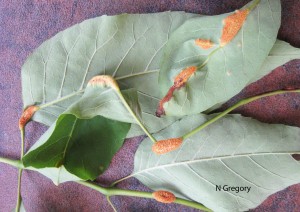Ash rust, caused by the fungus Puccinia sparganioides, is a disease which affects white and green ash in Delaware. Symptoms on ash appear in mid-May as small yellow to yellow-orange spots on upper leaf surfaces. About ten days later bright orange-yellow clusters of aecia (fungal spore producing structures) became apparent on leaf under surfaces. Leaves often become distorted and petioles may develop wart-like swellings which also bear clusters of aecia. Leaves with infected petioles wilt and die and severely affected trees appear scorched in June. Defoliation of heavily infected trees occurs, but in most cases, infected trees may push a flush of new growth. Repeatedly infected trees may be predisposed to winter damage and to secondary infection by wood decay organisms. 
The alternate host for ash rust is marsh and cord grass which is found in coastal areas. If the disease only occurs sporadically, chemical control is not needed, especially if the infected tree is otherwise healthy. It is very difficult to predict if the disease is going to occur and preventative fungicide applications would need to be applied at bud break. Spraying after infection has occurred will not result in control.
NFG 5/17/2017
Tag: ash rust
Ash Rust is Here!

We see ash rust almost every year, but this year there seems to be quite a bit of it. The fungal rust disease is very dependent on the spores produced by the alternate host (Spartina marsh grass). In cool, humid seasons with a bit of wind, infections are numerous on ash leaves as they expand. There is no control at this time. Rake up and remove leaves that fall, as they will produce spores that go back to the marsh grass. The ash trees can tolerate some infection year after year, but it does look unsightly. There is usually no need for chemical control, but fungicides would need to be applied preventatively, so mark your calendar for next year during the second week of May, to check your trees. At that time, a fungicide such as myclobutanil could be applied to specimen trees, according to the label.
